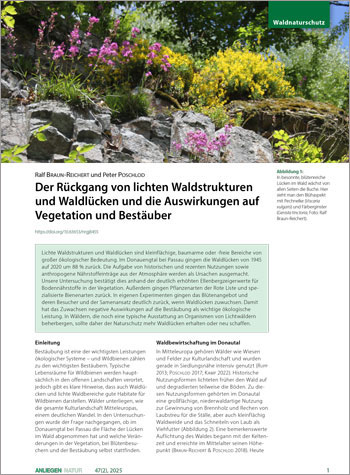Der Rückgang von lichten Waldstrukturen und Waldlücken und die Auswirkungen auf Vegetation und Bestäuber

In besonnte, blütenreiche Lücken im Wald wächst von allen Seiten die Buche. Hier sieht man den Blühaspekt mit Pechnelke (Viscaria vulgaris) und Färberginster (Genista tinctoria; Foto: Ralf Braun-Reichert).
Ralf Braun-Reichert und Peter Poschlod
https://doi.org/10.63653/nrgj8455
Lichte Waldstrukturen und Waldlücken sind kleinflächige, baumarme oder -freie Bereiche von großer ökologischer Bedeutung. Im Donauengtal bei Passau gingen die Waldlücken von 1945 auf 2020 um 88 % zurück. Die Aufgabe von historischen und rezenten Nutzungen sowie anthropogene Nährstoffeinträge aus der Atmosphäre werden als Ursachen ausgemacht. Unsere Untersuchung bestätigt dies anhand der deutlich erhöhten Ellenbergzeigerwerte für Bodennährstoffe in der Vegetation. Außerdem gingen Pflanzenarten der Rote Liste und spezialisierte Bienenarten zurück. In eigenen Experimenten gingen das Blütenangebot und deren Besucher und der Samenansatz deutlich zurück, wenn Waldlücken zuwuchsen. Damit hat das Zuwachsen negative Auswirkungen auf die Bestäubung als wichtige ökologische Leistung. In Wäldern, die noch eine typische Ausstattung an Organismen von Lichtwäldern beherbergen, sollte daher der Naturschutz mehr Waldlücken erhalten oder neu schaffen.
Summary
The decline of sparse forest structures and forest gaps and the effects on vegetation and pollinators
Forest gaps are considered as small natural features with large ecological roles. In the Danube valley near Passau, forest gaps decreased by 88 % between 1945 and 2020. The abandonment of historical and recent forms of forest use as well as anthropogenic nutrient depositions from atmosphere are identified as the causes. Our study confirms this because of a significantly increased Ellenberg indicator values for soil nutrients in the vegetation. Red List species in vegetation and specialised bees declined. The effects of climate change were clearly visible in the change of species composition of the wild bee community. Our experiments have shown that the overgrowth of forest gaps has a negative impact on the pollination function, from flower supply to flower visitation to seed set. For this reason, nature conservation in forests that still harbour organisms typical of light forests should focus more on the preservation and new creation of forest gaps.
Zum Volltext-Download:
Anliegen Natur 47/2 (2025): 8 Seiten als Volltext herunterladen (pdf barrierefrei 1,0 MB).
 | 0
| 0 

Zu diesem Artikel passt die „Mittelwaldähnliche Waldrandgestaltung“ von H. A. Gockel perfekt!!!